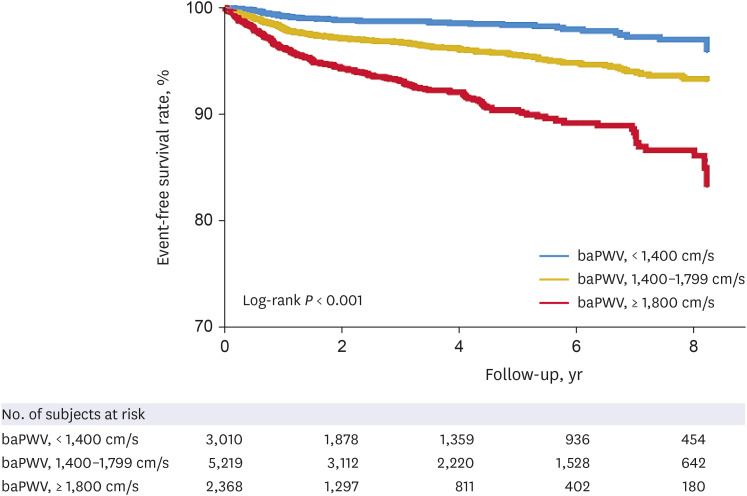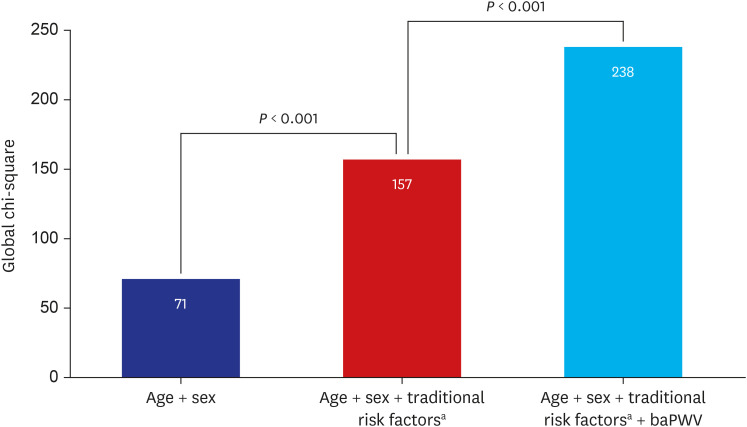J Korean Med Sci.
2023 Dec;38(50):e414. 10.3346/jkms.2023.38.e414.
Prognostic Value of Brachial-Ankle Pulse Wave Velocity According to Subjects’ Clinical Characteristics: Data From Analysis of 10,597 Subjects
- Affiliations
-
- 1Division of Cardiology, Department of Internal Medicine, Seoul Metropolitan Government-Seoul National University Boramae Medical Center, Seoul National University College of Medicine, Seoul, Korea
- 2Division of Cardiology, Department of Internal Medicine, Daejeon Eulji University Hospital, Daejeon, Korea
- KMID: 2549958
- DOI: http://doi.org/10.3346/jkms.2023.38.e414
Abstract
- Background
To make good use of the prognostic value of arterial stiffness, it is important to identify the population with the greatest benefit. In this study, we compared the prognostic value of brachial-ankle pulse wave velocity (baPWV) according to various clinical characteristics.
Methods
A total of 10,597 subjects who underwent baPWV measurement (mean age, 61.4 ± 9.5 years; female proportion, 42.5%) were retrospectively analyzed. Major adverse cardiovascular events (MACEs), defined as a composite of cardiac death, non-fatal myocardial infarction, coronary revascularization, and ischemic stroke were assessed during the clinical follow-up period.
Results
In the multivariate analysis, clinical variables with more than 4,000 subjects were selected as grouping variables, which were sex (men and women), age (≥ 65 and < 65 years), body mass index (BMI) (≥ 25 and < 25 kg/m 2), hypertension (presence and absence), estimated glomerular filtration rate (≥ 90 and < 90 mL/min/1.73 m 2 ), and statin use (user and non-user). During the median clinical follow-up duration of 3.58 years (interquartile range, 1.43–5.38 years), there were 422 MACEs (4.0%). In total study subjects, baseline higher baPWV was associated with increased risk of MACE occurrence (hazard ratio for baPWV ≥ 1,800 cm/s compared to baPWV < 1,400 cm/s, 4.04; 95% confidence interval, 2.62–6.21; P < 0.001). The prognostic value of baPWV was statistically significant regardless of sex, age, BMI, hypertension, renal function, and statin use.
Conclusion
Our results suggest that baPWV is not only effective in specific clinical situations, but can be effectively applied to predict cardiovascular prognosis in various clinical situations.
Keyword
Figure
Reference
-
1. Chirinos JA, Segers P, Hughes T, Townsend R. Large-artery stiffness in health and disease: JACC state-of-the-art review. J Am Coll Cardiol. 2019; 74(9):1237–1263. PMID: 31466622.2. Lee HY, Oh BH. Aging and arterial stiffness. Circ J. 2010; 74(11):2257–2262. PMID: 20962429.3. Ohkuma T, Ninomiya T, Tomiyama H, Kario K, Hoshide S, Kita Y, et al. Brachial-ankle pulse wave velocity and the risk prediction of cardiovascular disease: an individual participant data meta-analysis. Hypertension. 2017; 69(6):1045–1052. PMID: 28438905.4. Vlachopoulos C, Aznaouridis K, Stefanadis C. Prediction of cardiovascular events and all-cause mortality with arterial stiffness: a systematic review and meta-analysis. J Am Coll Cardiol. 2010; 55(13):1318–1327. PMID: 20338492.5. Cavalcante JL, Lima JA, Redheuil A, Al-Mallah MH. Aortic stiffness: current understanding and future directions. J Am Coll Cardiol. 2011; 57(14):1511–1522. PMID: 21453829.6. Laurent S, Cockcroft J, Van Bortel L, Boutouyrie P, Giannattasio C, Hayoz D, et al. Expert consensus document on arterial stiffness: methodological issues and clinical applications. Eur Heart J. 2006; 27(21):2588–2605. PMID: 17000623.7. Kim HL, Kim SH. Pulse Wave Velocity in Atherosclerosis. Front Cardiovasc Med. 2019; 6:41. PMID: 31024934.8. Kim BY, Kang SM, Kang JH, Kang SY, Kim KK, Kim KB, et al. 2020 Korean Society for the Study of Obesity guidelines for the management of obesity in Korea. J Obes Metab Syndr. 2021; 30(2):81–92. PMID: 34045368.9. Lee HS, Kim HL, Kim H, Hwang D, Choi HM, Oh SW, et al. Incremental prognostic value of brachial-ankle pulse wave velocity to single-photon emission computed tomography in patients with suspected coronary artery disease. J Atheroscler Thromb. 2015; 22(10):1040–1050. PMID: 26235347.10. Yamashina A, Tomiyama H, Takeda K, Tsuda H, Arai T, Hirose K, et al. Validity, reproducibility, and clinical significance of noninvasive brachial-ankle pulse wave velocity measurement. Hypertens Res. 2002; 25(3):359–364. PMID: 12135313.11. Park JB, Sharman JE, Li Y, Munakata M, Shirai K, Chen CH, et al. Expert consensus on the clinical use of pulse wave velocity in Asia. Pulse (Basel). 2022; 10(1-4):1–18. PMID: 36660436.12. Mattace-Raso FU, van der Cammen TJ, Hofman A, van Popele NM, Bos ML, Schalekamp MA, et al. Arterial stiffness and risk of coronary heart disease and stroke: the Rotterdam Study. Circulation. 2006; 113(5):657–663. PMID: 16461838.13. Sutton-Tyrrell K, Najjar SS, Boudreau RM, Venkitachalam L, Kupelian V, Simonsick EM, et al. Elevated aortic pulse wave velocity, a marker of arterial stiffness, predicts cardiovascular events in well-functioning older adults. Circulation. 2005; 111(25):3384–3390. PMID: 15967850.14. Willum-Hansen T, Staessen JA, Torp-Pedersen C, Rasmussen S, Thijs L, Ibsen H, et al. Prognostic value of aortic pulse wave velocity as index of arterial stiffness in the general population. Circulation. 2006; 113(5):664–670. PMID: 16461839.15. Guerin AP, Blacher J, Pannier B, Marchais SJ, Safar ME, London GM. Impact of aortic stiffness attenuation on survival of patients in end-stage renal failure. Circulation. 2001; 103(7):987–992. PMID: 11181474.16. Hametner B, Wassertheurer S, Mayer CC, Danninger K, Binder RK, Weber T. Aortic pulse wave velocity predicts cardiovascular events and mortality in patients undergoing coronary angiography: a comparison of invasive measurements and noninvasive estimates. Hypertension. 2021; 77(2):571–581. PMID: 33390046.17. Kals J, Lieberg J, Kampus P, Zagura M, Eha J, Zilmer M. Prognostic impact of arterial stiffness in patients with symptomatic peripheral arterial disease. Eur J Vasc Endovasc Surg. 2014; 48(3):308–315. PMID: 24962743.18. Kim HL, Jeon WK, Joh HS, Lim WH, Seo JB, Kim SH, et al. Brachial-ankle pulse wave velocity as a predictor of long-term cardiovascular events in 2174 subjects with type 2 diabetes mellitus: a retrospective cohort study. Medicine (Baltimore). 2022; 101(45):e31758. PMID: 36397444.19. Kim HL, Lim WH, Seo JB, Kim SH, Zo ZH, Kim MA. Prediction of cardiovascular events using brachial-ankle pulse wave velocity in hypertensive patients. J Clin Hypertens (Greenwich). 2020; 22(9):1659–1665. PMID: 32777179.20. Kim J, Song TJ, Song D, Lee KJ, Kim EH, Lee HS, et al. Brachial-ankle pulse wave velocity is a strong predictor for mortality in patients with acute stroke. Hypertension. 2014; 64(2):240–246. PMID: 24821942.21. Kim HL, Lim WH, Seo JB, Kim SH, Zo JH, Kim MA. Prognostic value of arterial stiffness according to the cardiovascular risk profiles. J Hum Hypertens. 2021; 35(11):978–984. PMID: 33184487.22. Balfour PC Jr, Gonzalez JA, Kramer CM. Non-invasive assessment of low- and intermediate-risk patients with chest pain. Trends Cardiovasc Med. 2017; 27(3):182–189. PMID: 27717538.23. Roifman I, Han L, Koh M, Wijeysundera HC, Austin PC, Douglas PS, et al. Clinical effectiveness of cardiac noninvasive diagnostic testing in patients discharged from the emergency department for chest pain. J Am Heart Assoc. 2019; 8(21):e013824. PMID: 31684795.
- Full Text Links
- Actions
-
Cited
- CITED
-
- Close
- Share
- Similar articles
-
- The Association of Brachial-Ankle Pulse Wave Velocity with Acute Postprandial Hyperglycemia in Korean Prediabetic and Diabetic Subjects
- Uric Acid Level Has a J-Shaped Association with Arterial Stiffness in Korean Postmenopausal Women
- Relationship between Cardiac Autonomic Neuropathy and Brachial-ankle Pulse Wave Velocity in Type 2 Diabetics
- Usefulness of Brachial-Ankle Pulse Wave Velocity and Ankle-Brachial Index as Predictors of Early Age-Related Maculopathy
- Pulse wave velocity and ankle brachial index in adolescents with essential hypertension



